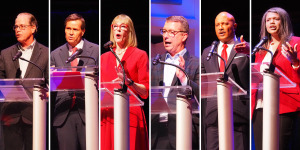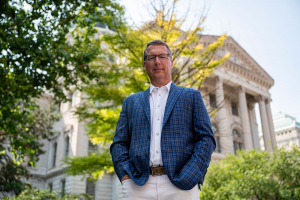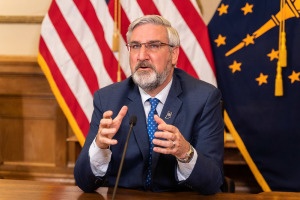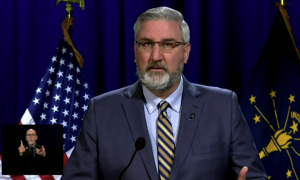Brad Chambers: Lifting rural economies requires further investment
There’s only one person in this race with a record of working to boost rural Indiana’s economy—with unprecedented results.
There’s only one person in this race with a record of working to boost rural Indiana’s economy—with unprecedented results.
U.S. Sen. Mike Braun, former Indiana Secretary of Commerce Brad Chambers, Lt. Gov. Suzanne Crouch, Fort Wayne businessman Eric Doden, former Attorney General Curtis Hill and political newcomer Jamie Reitenour weigh in on where they fall on the state’s biggest tax issues.

Most of the quips and jabs during the one-hour event were directed at frontrunner Sen. Mike Braun, with a focus on his track record in the Indiana General Assembly and Congress on topics including immigration policy, economic development and taxation.

With less than 50 days before polls close on the Hoosier State’s most competitive primary in decades, the Indiana Capital Chronicle will publish four issue-based question and answers with the six Republican candidates.

Right now, top-down economic development plans made in Indianapolis mainly benefit big corporations, big projects and big communities.
The well-funded gubernatorial candidate’s biggest challenge is name recognition, especially in the southern two-thirds of the state.

The Dali exhibition and a Van Gogh encore were announced during the annual meeting for the 140-year-old museum.

Eric Doden, a Fort Wayne businessman and Republican candidate, has $2.4 million in cash on hand and no debts, according to his latest finance report.
My hope is for Indiana to remain the vibrant, innovative and welcoming state that we are for many years to come. To do so, however, we must continue to be strategic and intentional in our workforce and economic development efforts.
The new Central Indiana Regional Development Authority initially would include Anderson, Carmel, Fishers, Indianapolis, McCordsville, Noblesville, Westfield and Zionsville.

Hitting our marks will also require greater focus on inviting and supporting more women and people of color into the sector.
We are excited to see what the IEDC chooses to fund in what we hope will be just the first round of READI grants—and we can’t wait to see what communities do with the money.
Gov. Eric Holcomb said interest in the Regional Economic Acceleration and Development Initiative, or READI, has surpassed the state’s expectations—so much so that the allotted $500 million in funding will fall far short of meeting every region’s vision.

The supermajority was ill-prepared for this largesse. It has had only two ideas: Cut taxes and build the surplus. There were too many dollars for this.
READI will encourage neighboring counties, cities and towns to partner and apply for grants of up to $50 million per region.
Population belongs on the list of Indiana’s most daunting long-term challenges, alongside education. Sure, our schools need to prepare more Hoosiers for success in the job market, but building our economy also takes more Hoosiers—period.
State lawmakers came through in big ways for business and manufacturing interests this year.

We must enact a plan not just around how to build and encourage industry to adapt and change, but also to maximize Indiana’s ability to compete over the next decade.
We’d like to see the governor be more specific about his proposal. He didn’t say, for example, how much money he wants to put behind it.
Normally, the governor gives the annual State of the State address before a joint session of the Indiana General Assembly inside the Indiana House chamber. But for safety reasons, Holcomb pre-recorded the speech without an audience.

